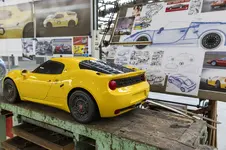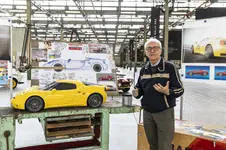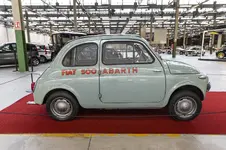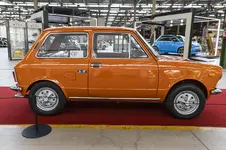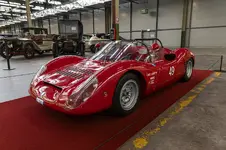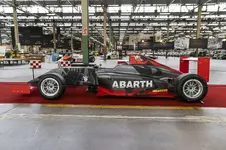#abarth #abarthheritage #abarthclassiche1300 #classiche1300ot #germancarforum
- To commemorate the Scorpion’s 75th anniversary, Stellantis’ Heritage team has organized two special tributes: a temporary exhibition featuring invaluable Abarth rarities, which belong to private collectors and the company’s permanent collection, and the announcement of the Abarth Classiche 1300 OT project.
- The exhibition at the Heritage Hub retraces the brand’s most important phases through some of its most famous vehicles, while the new project from Heritage’s “Reloaded by Creators” program is represented by a 1:3 scale model featuring every detail of the definitive form of the new vehicle.
- In addition to the 12 models at the museum’s entrance, 26 models can be found inside the exhibition area, allowing visitors to admire other lesser known, yet equally important, Abarth models further into the museum complex.
- The special guest will be the Abarth Classiche 1300 OT, an evolution of the Abarth Classiche 1000 SP created by Heritage in 2021 which came in just five models and sold out in record time.
- A modern reinterpretation of the iconic sporty vehicle from the 1960s, the Abarth Classiche 1300 OT is a dream which will soon become a splendid reality in a five-unit limited-edition run.
- Produced and sold by the Heritage Stellantis department, the new creation is already available for order. To receive further information, it is possible to visit the Heritage site or write to the following email address: heritage@stellantis.com.
- Starting on April 12th, the exhibition will be open to the public for around three months and a tour of the Heritage Hub is included with the purchase of a ticket. Bookings and purchases are available at the following link.
- To highlight the brand’s constant evolution, the exhibition will feature two of the latest Abarth models: the Abarth 500e with a Poison Blue livery and the brand-new Abarth 695 75th Anniversario.
Stellantis’ Heritage department is commemorating Abarth’s 75th Anniversary with two tributes to the Scorpion’s history: the captivating temporary exhibition inside the Heritage Hub which retraces the brand’s most important moments through some of its most famous vehicles, and the presentation of the “Abarth Classiche 1300 OT” with a 1:3 scale model on display at the commemorative event.
Roberto Giolito, Head of Stellantis Heritage (Alfa Romeo, FIAT, Lancia, Abarth), stated: “There is a common thread which links the Abarth vehicles of the past on display in the temporary exhibition which we have set up here in the brand’s home of Turin, and the thrilling Abarth Classiche 1300 OT, a dream which will soon become an incredible reality. This common thread can be found in the brand’s core values: superior performance, expert craftsmanship, and constant technical refinement—all of which were once represented by the brand’s iconic forerunners, and today are an integral part of the new project from the Heritage “Reloaded by Creators” program. Moreover, these are the same values which feature in the Scorpion’s current lineup, which proves that Carlo Abarth’s principles still serve as inspiration for the future. So, with this compelling exhibition and the announcement of the limited-edition Abarth Classiche 1300 OT, the Stellantis Heritage department (Alfa Romeo, FIAT, Lancia, Abarth) is not only commemorating human, sporting, and technological heritage, but paying tribute to the various generations of fans throughout the world who still expect both a thrilling drive and a distinctive style from the Scorpion and still have faith in the founder’s famous motto: “Sunday on the track and Monday in the office”.
With 12 vehicles at the museum’s entrance at the temporary exhibition, 26 models can be found inside the exhibition area, allowing visitors to admire other “lesser known”, yet equally important, Abarth models further into the museum complex. Specifically, the 12 vehicles up front come from private collectors and Stellantis’ collection: from the first 500 tuned by Carlo Abarth—the one with which he set six speed and endurance records on the Monza circuit in 1958—to the legendary 1960s’ Abarth 1000, the Abarth 500e with a Poison Blue livery, and the brand-new Abarth 696 75th Anniversario which pays tribute to the Scorpion’s history and the famous 1.4 T-Jet engine, whose displacement (1,368 cc) inspired the 1,368 models produced for its limited-edition run.
The 26 other incredible vehicles in the exhibition include the 750 Record Aero designed by a young Franco Scaglione and the 1000 Formulino which was driven by Carlo Abarth himself to set the brand’s 100th record. Visitors will also be able to admire the iconic 131 Abarth which won 3 Group 4 World Rally Championships, and the brutal 037, which, in 1983, was the last two-wheel-drive vehicle to win the World Rally Championship against all-wheel-drive competition. The exhibition also features some rarities like the elegant 2400 Coupé Allemano—Carlo Abarth’s personal vehicle in early 1960s—and the powerful Fiat 131 Supermirafiori "2000/TC Volumetrico” tuned by Carlo Abarth which Giovanni Agnelli used for everyday driving. Moreover, each vehicle on display at the commemorative event has rich a backstory which is sure to strike younger visitors and bring a smile, and a bit of nostalgia, to those who lived through Italy’s economic miracle, when Abarth was synonymous with speed, tuning, and emotion.
The exhibition’s special guest will be the Abarth Classiche 1300 OT model which is made in Epowood and includes fine details like a rear grill with “Abarth lettering”. Mechanically based on the 2009 Abarth Classiche 1000 SP project, which was derived from the Alfa Romeo 4C, this new creation is the evolution of the Abarth Classiche 1000 SP created by the Heritage team in 2021 which came in just five models and sold out in record time. Featuring a carbon-fiber body and the historic “periscope” reinterpreted in a contemporary key, the new Abarth Classiche 1300 OT is already available for order and will be produced in just five limited-edition models and sold by the Stellantis Heritage department (Alfa Romeo, FIAT, Lancia, Abarth). For further information, it is possible to visit the Heritage site or write to the following email address: heritage@stellantis.com.
Thanks to this compelling exhibition’s design which highlights the vehicles’ uniqueness in terms of design, technological innovation, and sporting success, the event dedicated to the Scorpion’s 75th anniversary is the perfect chance to admire these authentic “gems” of world motorsport. This incredible exhibition further enhances the Heritage Hub experience, which is normally open to the public with guided tours, and will be open for about three months starting from April 12th with the purchase of a classic guided visit at the museum in via Plava in Turin. Further information, bookings, and purchases are available at the following link.
Abarth Classiche 1300 OT: speed and passion
Abarth Classiche 1300 OT is the new vehicle designed by Heritage to pay homage to the iconic car that achieved racing success half a century ago. This special edition, within Heritage’s “Reloaded by Creators” project, offers to the enthusiasts the opportunity to own a contemporary reinterpretation of one of the most iconic cars from the 1960s. In 1965, the Fiat-Abarth OT 1300 stood out on the track for its exceptional agility and power, derived from an efficient elaboration of the Fiat 850.
Featuring a lightweight and aerodynamic fibreglass body and a distinctive “periscope” mounted afterwards to cool the cabin, the OT 1300 became an icon of Abarth innovation in racing cars. As of today, the Heritage team under the label “Abarth Classiche” pays tribute to those everlasting values with the new Abarth Classiche 1300 OT, a work that fuses style, performance, and history. Mechanically based on the Abarth Classiche 1000 SP project, from which the Alfa Romeo 4C was shaped, this new creation retains the essence of an authentic Abarth. The bodywork, now made of carbon fibre, newly introduces the characteristic “periscope” of the historic car, reinterpreted in a contemporary key. The slotted plexiglass rear window for cooling and the large rear grille for the engine compartment, featuring “Abarth” lettering, emphasize the bond with the historic design. The front end, with its sinuous curves, is reminiscent of Abarth sports cars of the past, with generous openings dedicated to cooling. Abarth Classiche 1300 OT represents the most authentic and genuine way to honor an epic car that is still in the hearts of all true enthusiasts of the Abarth brand around the world.
The car, produced in limited edition of five units, is already available for order.
The twelve Abarths starring in the Heritage Hub's temporary exhibition
Fiat Abarth 595 SS (1957)
The story of the two-cylinder Abarth began in November 1957 at the Turin Auto Show just a few months after the launch of the Fiat Nuova 500. Carlo Abarth, who had already been successfully developing vehicles based on the Fiat 600 for some years, was intrigued by the idea of expanding his “derivation” range to more affordable models for the general public and felt the new compact Fiat could be a good springboard. In February 1964, the “595 SS” was introduced with an increased power of 32 HP. The superior power was obtained via a Solex 34 PBIC carburetor paired to a special light-alloy intake manifold, the air filter cover, and pressure pipe. Aesthetically, the differences consisted in the SS writing on the front and rear hoods and “esse esse” written in italics on the dashboard. Starting in February 1964 many accessories also became available to personalize the small Abarth, including various axle ratios, the dashboard with four Jaeger instruments in black-painted aluminum, the Campagnolo magnesium wheels, and an incredible three-spoke, polished aluminum sporty steering wheel with a wooden crown and a horn button featuring the shield. The story of the Fiat Abarth 595/695 traces the same evolution as the vehicle they derived from, going from the F (1965) to the L (1968) and coming to an end in 1971.
Fiat 500 Record Monza (1958)
The 1958 Abarth "Record" was the first Fiat 500 tuned and modified by Abarth to demonstrate its potential and reliability. To improve its performance, Abarth made small adjustments to the engine and made it lighter, squeezing almost 26 HP from the two-cylinder engine. With this setup, the first Abarth-tuned 500 went over 120 km/h and lasted for 168 hours (i.e., 24 hours a day for seven days in a row) in Monza, setting one record after another.
Fiat Abarth 850 TC Nurburgring (1961)
The Fiat Abarth 850 TC (Turismo Competizione) was designed as a small sports car which would be perfect for both everyday use and on the track; it could even be considered as one of the luckiest transformations in Carlo Abarth’s career. Introduced in February 1961, the 850 TC borrowed the mechanical scheme of the FIAT 600 D with increased bore and stroke; therefore, the displacement rose to 847 cm3. The more powerful camshaft, the Solex 32 carburetor, the new air filter, the different crankshaft, and a new exhaust designed for sporting use allowed it to reach 52 HP and 5,800 rpm. All of this allowed the 850 TC to reach a 140 km/h top speed, which made it necessary to adopt a new braking system with discs in place of drums on the front wheels. In light of its bold racing personality, the Abarth 850 TC’s interiors featured an elegant Jaeger-designed instrument cluster and a sporty three-spoke aluminum steering wheel. The 850 TC cost 850,000 lire and a warranty was offered on the vehicle for the first time. In November 1961, the Abarth 850 TC Nürburgring was introduced, which came standard with a horseshoe-shaped instrument cluster, a sporty steering wheel, and signature writing.
Fiat Abarth 1000 SP (1966)
This automobile project was given the code name SE04, but commercially would be known as the 1000 SP (Sport Prototype). The plan was to produce at least 50 were for homologation in the Sport Group 6 category and for private drivers. Its mechanics were derived from the Fiat 600 engine block with a tested 982 cm³ twin-shaft engine, which was used for two reasons: on the one hand, it maintained a link with Fiat and, on the other hand, this kind of engine guaranteed reliability. The compression ratio was 10.5:1, and fueling was entrusted to two twin-choke Weber 40 DCOE2 carburetors which supplied 105 HP. With a weight of just 480 kg, the top speed was over 220 km/h, and it featured a four-speed gearbox. The vehicle’s front was razor-sharp to allow for adequate air flow through the openings which led to the water radiators. The body was made in fiberglass to reduce its overall weight.
Fiat Formula Italia (1972)
The “Formula Italia” or the SE 025 was made in 1971 as a training car for young Italian motorsports drivers. The Fiat 1600 cc-derived engine, which was paired with the Lancia Fulvia coupé HF 1.6’s manual gearbox and two twin-choke Weber 40 DCOE2 carburetors, ended up reaching 115 HP at 6,500 rpm. The vehicle was introduced on October 26, 1971 at the same time as the competition promoted by the Italian Motorsport Commission. The front four-spoke alloy wheels came from the 124 Spider Abarth, while the rear ones came from the Fiat Dino 14”. Meanwhile, the steel-tube chassis and the flame-retardant GFRP body were specifically designed for the competitions. The overall weight was around 450 kg and the top speed exceeded 200 km/h. The Formula Italia had both impressive commercial and competitive success: a few dozen models were produced in 1972 which gave life to the single-brand competition over six races.
Fiat Abarth 124 Rally (1972)
Introduced at the Turin Auto Show in 1972 with an engine with 1,800 cm³ of displacement, this vehicle was the new version of the 124 Sport Spider and named the Abarth Rally. With a no-frills cabin, it did not feature a console on the central tunnel or glovebox and opted for aluminum in place of the wood paneling; meanwhile, its door panels were simplified and included gorgeous anatomical seats (optional, and yet ubiquitous) and a leather-upholstered, three-spoke steering wheel. This “scenery” was wholly justified as the engine, which was modified through the adoption of two 44 mm Weber carburetors, reached 128 HP instead of 144. This was more than enough to ensure a satisfying drive and could be easily increased thanks to the incredible response to the tuning provided by this exquisite vehicle. In any case, the differential, by request, could become limited-slip and the work carried out on the chassis was essential for power management. The front suspensions were modified and the rear ones underwent a real revolution: the rigid bridge made way for a system of independent wheels with MacPherson struts and wishbones anchored at the center of the vehicle with an adjustable anti-roll bar. It didn’t take much effort to sell the 1,013 models produced, even with a more limited color range of red, blue, and white. The car was incredibly fast: over 190 km/h and from 0-100 km/h in about 8 seconds.
Autobianchi A112 Abarth 58 HP (1972)
The A112 was made in 1969, just after the full takeover of Autobianchi by Fiat, and produced for more than 17 years in seven different series. Introduced at the Turin Auto Show on September 15, 1971, it was given the name Autobianchi A112 Abarth 58 HP due to the power produced by its engine—a 982 cm³ inline-four engine for 58 DIN HP at 6,600 rpm powered by a vertical double-body Weber 32 DMTR carburetor. The top speed of the 58 HP was 150 km/h, around 10 km/h more than the standard version, and it went from 0-100 km/h in around 12 seconds. The launch price was 1,325,000 lire. From a stylistic point of view, it distinguished itself from the “non Abarth” version with its matte-black hood, as well as its rocker panel, the wheel arches and the lower part of the rear, the hexagonal Scorpion badge and the Autobianchi one on the side near the door frame, and its one-of-a-kind grille with two round air intakes which looked like two headlights. It came in a Racing Red color, even if some rare models had Salmon and Mink liveries without black elements. The new A112 range made its debut in March 1973; and we cannot go without mentioning the sporty versions: the A112 Abarth 58 HP 2^ Series and the Autobianchi A112 Abarth 70 HP (3^ series) introduced at the beginning of 1975.
Fiat Abarth 131 Rally (1976)
The Fiat 131 Abarth road vehicle was introduced at the Geneva International Motor Show held during the first week of March 1976. The design and the production of the body were entrusted to the Centro Stile Bertone where, through use of fiberglass and aluminum, a lighter vehicle was created with a look inspired by the two-door Fiat 131 Mirafiori. To reduce the body’s weight, the 131 Abarth Rally featured resin hoods and fenders and aluminum doors. Larger wheel arches and spoilers were then added to ensure the necessary downforce. The engine powering the vehicle designed by Abarth’s technicians was an unprecedented 1,995 cm³ inline-four engine with a light aluminum head, double overhead cam, 16 valves, and Kugelfischer mechanical injection in the “Corsa” version. The road version with a Weber double-body carburetor supplied 140 HP, while the fuel-injection racing ones reached 225 HP, which later would be brought to 245. The five-speed dog ring gearbox, for the 131 Abarth road vehicles as well, and the ZF limited-slip differential (only on the Corsa) provided power to the lowered Pirelli P7 tires. Made between 1976 and 1987 in 400 models—the minimum number for homologation in the Corsa version in Group 4 according to FIA rules—the Fiat 131 Abarth Rally Gr.4 quickly made a name for itself in competitions around the world.
Abarth Formula 4 (2014)
Abarth stayed true to its historical role as a springboard for Motorsport talents by taking a leading role in the Italian Formula 4 Championship, the new series commissioned by the FIA which allowed young drivers to get experience in a single-seater and embark on a professional career in motorsport. Formula 4 offers young drivers the chance to step into a real single-seater at just 15 years of age and compete against other drivers in total technical parity, ensured by, for example, the sealing and rotation of engines between the participating cars. As proof of the program’s educational scope, the young drivers are supervised on the tracks by tutors who teach them the secrets of the trade and follow them race by race in this professional-track program. Italian Formula 4 Championship’s rules provide for three races for each of the eight events which take place on technical and international circuits.
Abarth 124 Rally (2016)
Introduced for the first time in March 2016 at the Geneva International Motor Show and later at the 100th Targa Florio, the Abarth 124 Rally made its rally debut at the Italy-Sardinia Rally. A concentration of pure technology and performance, this vehicle came out of Squadra Corse Abarth’s experiences and was aimed at bringing the Scorpion back to the best and most difficult rally tracks—special stages where the asphalt is hotter and the ice is more slippery. 40 years after its last official race at the 1976 Monte Carlo Rally, the Abarth 124 rally came back with the same philosophy: testing the technical solutions of road vehicles in the most extreme conditions and providing every Abarth customer with the best performance and greatest reliability. It was dedicated to all of those who share the brand’s sense of adventure and the values of the racing world. Hiding under the hood, one could find the double shaft direct-injection turbo engine. Thanks to the various selectable mappings, it guaranteed power up to 300 HP at 6,500 rpm and superior torque curve, which is fundamental to allowing driver steering and acceleration balance while oversteering.
Abarth 695 Rivale (2017)
Out of the meeting between Abarth and Riva, the Abarth 695 Rivale was born—the special and limited series which combined the tradition and innovation of two major brands in the Italian manufacturing industry. The Abarth 695 Rivale set itself apart from all other vehicles. The limited and customizable series’ identification plate attached with the same screws used in the construction of Riva yacht was one of the many elements which attested to its dual soul of elegance and sportiness. Two timeless legends—one on the road and the other on the sea—who shared years of international records and prestigious victories, it seemed natural for Carlo Abarth and Carlo Riva to collaborate and create a model founded on essentials like tradition, elegance, and innovation. When Abarth met Riva, the result was the perfect and harmonious combination of refinement and performance. This special and limited series was driven by aesthetics and came in 175 and 175 hatchbacks with a black glass sunroof.
Abarth Classiche 1000 SP (2021)
In 2021, Abarth Classiche decided to bring back the Abarth 1000 SP and create five models of the 1000 SP with the technical and mechanical features which it should have had since its first design in 2009 and which can be found today on the Alfa Romeo 4C. The sinuous car body—with the soft surfaces of the fenders which highlight the position of the wheels—called back to the spider’s mid-engined layout. The geometries of the rear of the Abarth Classiche 1000 SP underlined the perfect harmony between the lighting and exhaust units. The livery came mainly in red and one could find air intakes along the entire body—from the front hood to the cooling slots on the rear one. Even the lights fell in line with the minimalist design of the historic 1000 S, with point lights on the front and just a pair of round taillights to highlight the considerable width of the car when seen from behind.
A selection of Abarth cars full of records and curiosities
The exhibition dedicated to the Scorpion also continues in the Heritage Hub's innermost spaces, where other Abarth classic cars are on display: these include important cars that are already the subject of the guided tour as well as some models that are less “visited” by guests as they are far from the spotlight of the museum's themed areas, but no less valuable. Among them are the Abarth record-breaking cars, including the 750 Record Aero, designed by the young designer Franco Scaglione when he was working at Carrozzeria Bertone, the 1000 Record Aero, nicknamed “the Princess”, and the 1000 Formulino, which was piloted directly by Carlo Abarth to win the company's 100th record. An even grittier and more markedly racing appearance for the following models from the Heritage collection included in the exhibition itinerary: the iconic 131 Abarth, winner of three Group 4 World Rally Championships; the brutal 037, the last two-wheel-drive car to win the 1983 World Rally Championship ahead of all-wheel-drive contenders; the famous S4 Martini, the last rally car of the Lancia / Abarth team to race in Group B, and the equally renowned 124 Rally Gr.4 in which the famous driver Marku Alen began his career in the Fiat Group. Likewise, visitors will be impressed by two racing cars: the ECV prototype, created by the Lancia / Abarth team that did not participate in any rally races in Group B, and the powerful LC 2 conceived by Abarth engineering for endurance competitions and equipped with an 8-cylinder Ferrari engine. Rounding off this array of Sportiness at the highest level are two on-road cars, thanks to which their respective rally versions were homologated: the Lancia Rally Stradale, one of 200 pieces required for the homologation of the Lancia 037, and the Lancia S4 Stradale, which was produced in 200 units to enable the legendary Lancia Delta S4 to participate in the World Rally Championship in Group B. Room was also given to some absolute rarities, such as the extremely elegant 2400 Coupé Allemano, Carlo Abarth's personal car in the early 1960s, and the powerful Fiat 131 Supermirafiori "2000/TC Volumetrico" with Abarth tuning created expressly for Lawyer Giovanni Agnelli, who drove it on his daily commutes. More standard but certainly no less appealing is the A 112 58 HP, the last series car creation supervised by Carlo Abarth, and the A 112 from the 5th series, which, in Abarth version, ended its production cycle at the Desio (MI) plant. Moreover, along the exhibition tour, many of the visitors will be reminded of the years of their youth by admiring the brilliant Seicento Sporting Limited Edition Michael Shumacher, the Uno Turbo Trofeo, which took the place of the A112 Abarth in the Fiat Group's training trophy, and the Stilo HGT, which featured the Scorpione logo on its wheel caps.
And great curiosity will certainly be aroused by the revolutionary Beta Turbo Montecarlo, an endurance car equipped with a 1400 cc Abarth engine turbocharged by two KKK turbos; and the peculiar Beta Trevi Bimotore, which Abarth's chief test driver, Giorgio Pianta, had built to test four-wheel drive; the 131 Abarth Diesel, winner of the London-Sydney 1977; la 500 Abarth Tokyo, the first prototype of the modern 500 Abarth; the 500 Trofeo Assetto Corsa, the star of the 2008 single-make trophy; the 124 Spider GT4, developed in 2015 to run in the GT4 formula; and the special 124 Spider 70th series which, together with the 595, celebrated Abarth's 70th Anniversary.
Abarth’s legend: from its birth in 1949 to the Scorpion’s New generation
The legend of the brand with the Scorpion badge started on March 31, 1949, when Carlo Abarth (1908-1979) founded Abarth & C. with driver Guido Scagliarini. Their first car was the 204 A derived from the Fiat 1100. It commanded attention on April 10, 1950, when Tazio Nuvolari drove it to win his last race, the Palermo-Monte Pellegrino. Since then, the history of Abarth has been full of racing and industrial records, always in the spirit of the founder to combine maximum performance, craftsmanship and constant technical refinement.
One of Carlo Abarth’s greatest ideas was to supplement racing activities with the production of his famous tuning kits for mass-production cars to increase power, speed and acceleration. Noteworthy components of the kit were the exhaust pipes, which, over the years, became a true icon of the "Abarth style". In the space of just a few years, Abarth & C. went global. By 1962 it was producing 257,000 exhaust pipes, 65% of which were destined for export markets. The pinnacle of success came at the end of the 1950s and in the 1960s. For example, with the Fiat Abarth 750 designed by Bertone in 1956, the brand broke the endurance and speed record. On June 18th on the Monza racetrack, it broke the 24-hour record covering 3,743 km at an average speed of 155 km/h. Then, from June 27th to 29th on the same circuit, it racked up a number of records: the 5,000 and 10,000 km, the 5,000 miles and also the 48 and 72 hours. The same vehicle was designed by Zagato in two different versions: the Fiat Abarth 750 Zagato (1956) and the Fiat Abarth 750 GT Zagato (1956). The roar of the car reached the ears of Franklin Delano Roosevelt Jr., son of the president of the USA, who rushed to Italy to personally sign an exclusivity contract for the distribution of these vehicles with Abarth.
In 1958, Abarth completed a true work of art on the new Fiat 500, completely transforming the small utility car and enhancing its potential to the maximum. In the same year, the brand intensified its partnership with Fiat, as Fiat committed itself to awarding Abarth cash prizes based on the number of victories and records that the team achieved. This event formed the basis of the impressive winning streak that was to come: 10 world records, 133 international records, more than 10,000 victories on the track. The legend continued to grow more and more, becoming a household name. The 1960s were the golden decade for Abarth. "Abarth" became synonymous with speed, courage, performance and development. And the list of vehicles which engraved the name of Abarth in the history of motor racing is a long one: from the 850 TC, which was victorious on all the international circuits including the Nürburgring, to the Fiat Abarth 1000 Berlina and the 2300 S that strung up an extraordinary series of records on the Monza track despite the harsh weather conditions. In 1971 Abarth was wholly taken over by the Fiat Group and the legend continued with the Fiat 124 Abarth, winner of the 1972 and 1975 European title, the 131 Abarth, world rally champion in 1977, 1978 and 1980, and the Ritmo Abarth. Sadly, Carlo Abarth passed away on October 24, 1979 during the Scorpio season—his astrological sign and the inspiration for the badge on his cars.
The glorious past was actualized again in 2008 when the brand was relaunched with a new line-up created for motorsports enthusiasts, like the Abarth Grande Punto (2007) and the Abarth 500 (2008); in addition to tuning kits for each car, there was also the racing versions of the Abarth Grande Punto Rally Super 2000 and the Abarth 500 Assetto Corse. Since then, new models have been launched thick and fast: the Abarth 695 Tributo Ferrari (2010), the Abarth 595 Yamaha Factory Racing (2015), the Abarth 695 Biposto Record (2015), the Abarth 695 Rivale (2017), the Abarth 124 spider (launched in 2016), the Abarth 124 GT, the new Abarth 595 range (both introduced in 2018), and the exclusive Abarth 695 70th Anniversary equipped with the new Spoiler ad Assetto Variabile.
Then in 2020, the legend of the Scorpion continued with the Abarth "70th Anniversary" range on Abarth 595 and Abarth 124, in addition to the new Abarth esseesse 595 and Abarth 124 Rally Tribute. This brings us to the recent past with the debuts in 2022 of the Abarth 695 Tributo 131 Rally special series and the New Abarth 500e—completely electric, faster, and more thrilling in both city and rural driving. Yet again in 2022, to highlight the brand’s increasing international presence, Abarth continued its global expansion with the Brazilian launch of the New Abarth Pulse, the historic brand’s first SUV. Abarth was proud to go beyond European and Asian borders once again with the introduction of the Abarth Fastback one year later. Lastly, the new 695 75° Anniversario made its debut earlier this year —a limited edition of only 1,368 units to celebrate the brand's 75th Anniversary and pay homage to the T-jet engine. In addition, on the 31rst of March, Abarth’s birthday, three exclusive pictures have been released of the New Abarth 600e with 240HP – the most powerful Abarth ever – with its Scorpionissima launch version that will be produced in a limited run of 1,949 units. This is the most challenging project developed by the brand in recent years which, once again, contributes to reach Abarth founder’s one true objective: “To transform the ordinary into the extraordinary”.
Continue reading...




